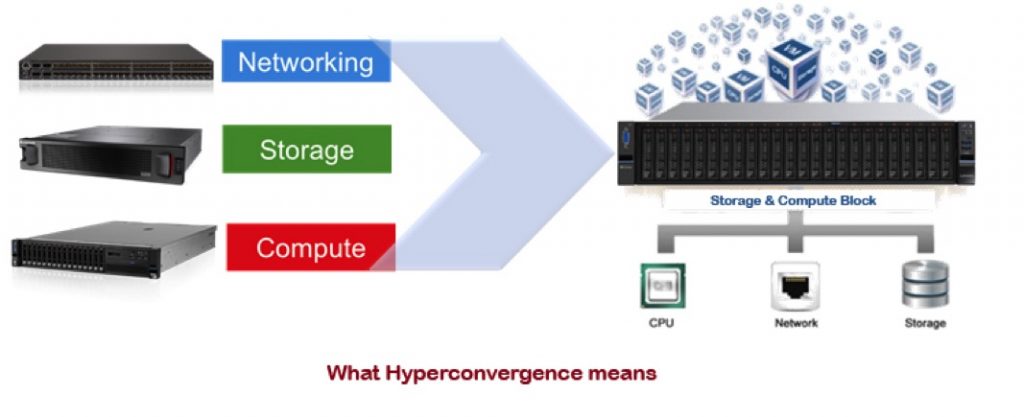Differentiating Between High-End and Standard HCI Architectures
By Jerome Wendt, DCIG
This is a Press Release edited by StorageNewsletter.com on August 3, 2018 at 2:31 pm Article written by Jerome M. Wendt, president and lead analyst, DCIG, Inc.
Article written by Jerome M. Wendt, president and lead analyst, DCIG, Inc.
Differentiating between High-end HCI and Standard HCI Architectures
Hyper-converged infrastructure (HCI) architectures have staked an early claim as the data center architecture of the future.
The abilities of all HCI solutions to easily scale capacity and performance, simplify ongoing management, and deliver cloud-like features have led many enterprises to view it as a logical path forward for building on-premise clouds.
But when organizations deploy HCI at scale (more than eight nodes in a single logical configuration), cracks in its architecture can begin to appear unless organizations carefully examine how well it scales. On the surface, high-end and standard hyper-converged architectures deliver the same benefits. They each virtualize compute, memory, storage networking, and data storage in a simple to deploy and manage scale-out architecture. They support standard hypervisor platforms. They provide their own data protection solutions in the form of snapshots and replication. In short, these two architectures mirror each other in many ways.
However, high-end and standard HCI solutions differ in functionality in ways that primarily surface in large virtualized deployments.
In these environments, enterprises often need to:
• Host thousands of VMs in a single, logical environment.
• Provide guaranteed, sustainable performance for each VM by insulating them from one another.
• Offer connectivity to multiple public cloud providers for archive and/or backup.
• Seamlessly move VMs to and from the cloud.
It is in these circumstances that differences between high-end and standard architectures emerge with the high-end HCI architecture possessing four key advantages over standard HCI architectures.
Consider:
1 Data availability. Both high-end and standard HCI solutions distribute data across multiple nodes to ensure high levels of data availability. However, only high-end HCI architectures use separate, distinct compute and data nodes with the data nodes dedicated to guarranteeing high levels of data availability for VMs on all compute nodes. This ensures that should any compute node become unavailable, the data associated with any VM on it remains available.
2 Flash/performance optimization. Both high-end and standard HCI architectures take steps to keep data local to the VM by storing the data of each VM on the same node on which the VM runs. However, solutions based on high-end HCI architectures store a copy of each VM’s data on the VM’s compute node as well as on the high-end HCI architecture’s underlying data nodes to improve and optimize flash performance. High-end HCI solutions such as the Datrium DVX also deduplicate and compress all data while limiting the amount of inter-nodal communication to free resources for data processing.
3 Platform manageability/scalability. As a whole, HCI architectures are intuitive to size, manage, scale, and understand. In short, if you need more performance and/or capacity, one only needs to add another node. However, enterprises often must support hundreds or even thousands of VMs that each must perform well and be protected. Trying to deliver on those requirements at scale using a standard HCIA solution where inter-nodal communication is a prerequisite becomes almost impossible to achieve. High-end HCI solutions facilitate granular deployments of compute and data nodes while limiting inter-nodal communication.
4 VM insulation. Noisy neighbors – VMs that negatively impact the performance of adjacent VMs – remain a real problem in virtual environments. While both high-end and standard HCI architectures support storing data close to VMs, high-end HCI architectures do not rely on the availability of other compute nodes. This reduces inter-nodal communication and the probability that the noisy neighbor problem will surface.
HCI architectures have resonated with organizations in large part because of their ability to deliver cloud-like features and functionality with maintaining their simplicity of deployment and ongoing maintenance. However, next generation high-end HCI architecture with solutions available from providers like Datrium provide organizations greater flexibility to deliver cloud-like functionality at scale such as offering better management and optimization of flash performance, improved data availability, and increased insulation between VM instances.
To learn more about how standard and high-end HCI architectures compare, check out this recent DCIG pocket analyst report that is available on the TechTrove website.















 Subscribe to our free daily newsletter
Subscribe to our free daily newsletter

